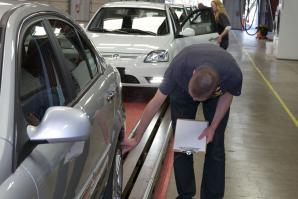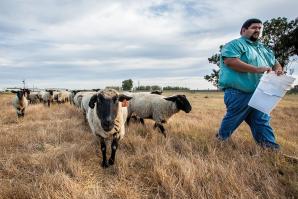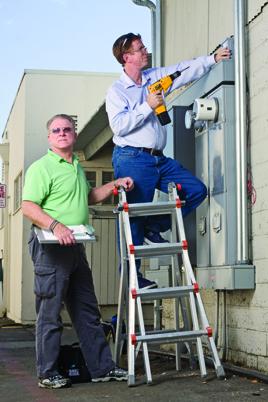Charles Rieger is building a case for going green. As the executive director of the Solano Center for Business Innovation, the umbrella organization for the newly formed Solano Green Business Council, it’s Rieger’s job to plant the seeds for a greener economy.
It’ll work, he says, but it has to be a coordinated effort for and by business.
“By working together, we can collectively solve the real problems that keep businesses from growing,” Rieger says.
Rieger’s vision is a nexus that leverages market opportunities in alternative energy, transportation, residential retrofits and energy and water efficiency.
So far, there’s a coordinated marketing campaign that includes an 800-number and website outlining energy rebates available in the county and references to businesses that can help with weatherizing, energizing and greening a building. This would be a marked improvement over the current system in which small-business owners struggle to keep up with changing incentive programs from local, state and federal agencies and utilities.
A self-funded microloan program, certification program and countywide buy-local pledge could also nurture green businesses.
Lance Denney, president of Rio Vista-based Green Environmental Technologies, says cross-pollinating these interests could be a powerful stimulus for the economy. Denney installs air and water purifiers along with energy conservation equipment for commercial and residential customers.
Because of his participation in the group’s first few planning meetings, he says he has already enrolled in certification classes for the U.S. Green Building Council’s Leadership in Energy and Environmental Design program.
“If this group can help just one business stay open, that can have a big impact countywide,” Denney says.
Larry Asera, owner of Asera Group Inc. on Mare Island, agrees that having all the right people can help grow a green economy. Asera’s company builds wind and solar projects. He says he was happy to see government and economic development representatives at the table along with education and business interests from across the county.
“The right cross-section of interests focused specifically on growing green business can facilitate development,” Asera says.
Rob Henley, principal of Henley Architects and Associates in Vacaville, joined the steering committee for the Green Business Council because “it is the right thing to do socially.”
However, he also says educating the public about the resources to implement green practices is a benefit to his business.
“There is still a perception that green can cost a lot of money, but that doesn’t have to be the case,” he says.
Mike Ammann, president of the Solano Economic Development Corp., which is working with the Solano Center for Business Innovation to launch the Green Business Council, is eager to put a stake in the ground.
“We are lagging [behind] our neighbors in the Bay Area and Sonoma and Sacramento counties,” he says. “If we don’t do this, someone else is going to take advantage of the market.”
Ammann points to a recent Solano County Index of Economic and Community Progress report and subsequent Energy Cluster Index as ammunition that the region is fertile ground for clean energy and transportation businesses. The reports showed seeds of a green economy already in place in Solano. They just need some nurturing.
The California Energy Commission reported that Solano County â?¨was home to 600 megawatts of energy capacity by 2009.
Since 1995 clean energy has outpaced traditional carbon-based companies in fueling job growth. Alternative energy jobs in the sector grew 72 percent compared with 30 percent growth for all job categories and just 4 percent for carbon-based jobs.
Part of the reason for the disparity is the maturation of the established oil and gas drilling and petroleum refining generation and distribution industry. The 40 companies that make up this sector experienced only two years of annual growth between 1995 and 2007 and today employ about 1,200 people, according to the report.
Meanwhile, the 20 identified clean-energy companies rushed to establish footprints in solar and wind generation, energy conservation and clean transportation. They grew from 200 to 350 jobs in the same amount of time. The California Energy Commission reported that Solano County was home to 600 megawatts of energy capacity by 2009.
In fact, the Northern California Solar Energy Association ranked Vacaville No. 2 among medium-sized cities for total wattage generated by solar panels in the city. Much of this innovation was initiated by business. Meyer, a Fairfield kitchen product manufacturer, installed a 580-kilowatt rooftop solar system; Alza Corp., a Vacaville pharmaceutical manufacturing company, installed a 1-megawatt solar farm; and Budweiser installed a 1.2-megawatt system in Fairfield.
Solano is home to more than 600 megawatts of wind-generation capacity and 12.5 megawatts of hydroelectric generation capacity.
“We are home to a natural wind corridor,” Ammann says. “We have to take advantage of that.”
Unlike many other sources of alternative energy in the state, urban Solano County is in close proximity to the state’s largest transmission lines. That makes getting power to the people much more efficient.
Two other essential elements for a healthy green economy are investment and innovation. Solano is situated between the Bay Area and UC Davis, Reiger says, and should take advantage of it. University research was the driving factor in establishing the Dixon electric vehicle research and development site for Palo Alto-based Efficient Drivetrains Inc.
Business growth could be stifled if companies don’t have a steady supply of trained employees ready in the pipeline. That’s why a green-jobs training program is already in place. However, the challenge is coordinating that training with the demand.
Robert Bloom, president of the Workforce Investment Board of Solano County, says developing a green economy is all about timing. His agency focuses on training a work force that will be ready when the jobs are available. To do that, he works closely with organizations such as the Solano Center for Business Innovation to gauge employer plans. Statistics from the Energy Cluster Index show that green businesses experienced up to 20 percent annual growth while traditional businesses declined.
That makes green job training a priority.
“In a county that already houses solar, now we need to train the people who can do the maintenance,” Bloom says. For example, working with unions to develop the programs that will upgrade the skills of the existing work force. “We should have started three years ago.”
Not all green jobs are the same. They range from installers to researchers and everything in between. “We can’t just train technicians,” Bloom says. “We need to train salespeople as well.”
In 2009, Solano Community College received a $419,000 grant from the state Employment Development Department to establish a green building and clean energy pre-apprenticeship program. Students in Fairfield, Vacaville and Vallejo can learn electricity installation and design principles, water-efficient building and retrofit skills and energy fundamentals so they can hit the roof running.
Paul Fair, the program’s coordinator, says: “We have to develop the real skills to put people to work. Solano is the ideal place to do that.”
That’s why he says he made sure he was one of the people at the Solano Green Business Council table with business and government representatives. All of these constituencies have to work together if they are going to have a major impact.
“A healthy economy is based on a diversified business environment,” Fair says. “It’s time to develop green.
Recommended For You

The Green Flash
There's energy in Solano's technology sector
An influx of green manufacturing companies and a burgeoning renewable-energy sector is creating the critical mass Solano County needs to usher in a new era of competitive economic growth.

Rearing an Industry
How Solano County is cultivating its ag economy
Solano County is taking steps to develop a new agricultural hub that farmers and economists hope will someday house facilities to process raw ag products into purchasable commodities.




Comments
I've since installed a Solar system on my home, and the 1st year went Net Zero! PG&E hates me I'm sure! Solar owners are why energy companies are lobbying our bought elected officials to allow them to CHARGE solar energy makers MORE MONEY as a FEE, even tho we already pay a "Competition Fee" that was supposed to go away 5 years ago! Now it's twice as high! My excess electricity goes next door, 10 feet away, but PG&E charges them at least 10,000 times what it costs to get there anyway! They "credit me" 3 1/2 cents /kWh for all the excess electricity I produce during the summer. (They'd rather owe it to me that cheat me out of it... which they are LEGALLY allowed to do if I produce too much throughout the year. Thanks to conservative's Citizens United)
LATER- PGE since switched my meter to a SMART meter, which is smart enough to tell them anything they want to know about my use and time of use, so they can CHARGE me more for their "NEW" Peak periods... when the SUN GOES DOWN! Where's those batteries Elon? And yes, we did use Elon's Solar City for our Energy Upgrade Ca Solano County Grant. They are now just "Tesla".
ALSO... my kids had to move back for family reasons, then COVID, the energy bill doubles and the Solar array wasn't nearly enough to handle it. Tesla sales person then told me they COULDN'T add to my Solar array, altho that was a BIG selling point for me getting it! Still working on it. PG& sent me a True-Up bill for $4000! Tried to take it all at once, so... LIMIT your autopay!